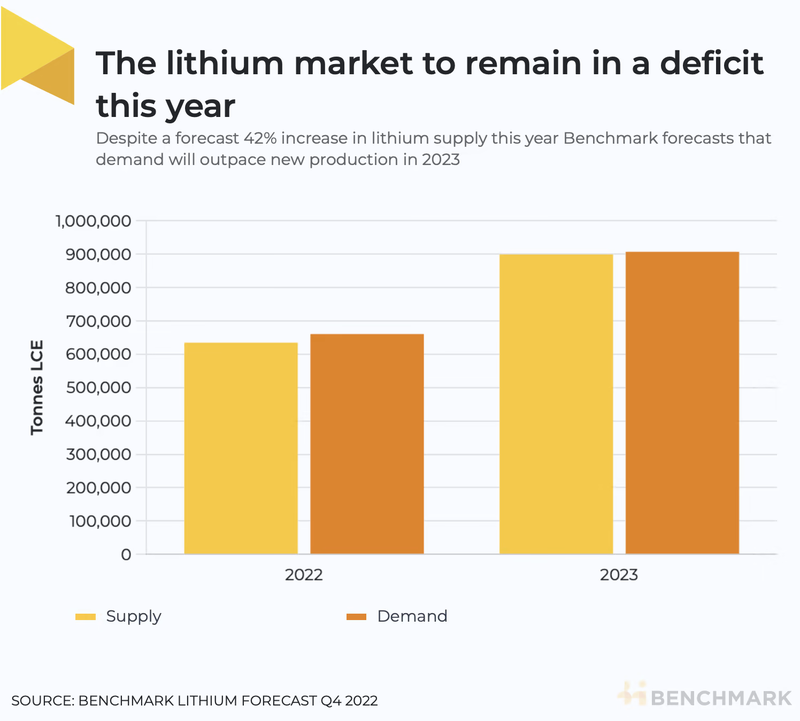Macro Outlook Lithium - 2023
Lithium is a component in virtually all batteries that power electric vehicles (EV) and many consumer electronics, that has already seen a sharp rise in demand (and price) over the past five years.
New lithium mines are notoriously hard to build and can take ~7-10 years to bring online.
In contrast, battery manufacturing capacity can be built in less than 3 years.
We think that the supply/demand imbalance in the lithium market comes from this mismatch in ability to come to market with new supply.
With lithium demand surging from the billions of $ being invested into battery manufacturing capacity there is a lag in the number of new mines being built.
Discover the 10 Lithium Stocks We've Invested in for 2023 and Beyond
We think that the lithium price will remain high for quite a while longer whilst mining capacity attempts to catch up to demand over the next 5-10 years.
We note that while the global economy is forecast to weaken over the coming year, the bullish case for battery metals, including lithium, extends well beyond the short term.
This is a decade-long story in which planned lithium supply is well short of projected demand.
For some context on the sector’s growth to date, global EV sales caused lithium consumption to double with new production unable to keep up with demand. According to Bloomberg the $ value of the lithium consumed in 2022 was US$35BN, up from US$3BN in 2020
Who else likes it
Benchmark Mineral Intelligence
Benchmark Minerals, which provides market intelligence for lithium and other battery materials, said demand for the battery material will grow about 40% in 2023 against 2022.
Benchmark boss Simon Moores says don’t worry about this short term [lithium price] slip, because the medium-long term outlook is still solid and that it still remains close to all-time highs with demand outstripping supply.
Moores said, “Lithium’s medium long term price will keep every resource development project in economic play”. He also notes that a falling price doesn’t necessarily mean a shrinking market and during lithium’s last falling price environment from 2018-2020, the market grew by 30%.

Joe Lowry
Global Lithium LLC founder and lithium expert Joe Lowry expects the price of battery quality lithium carbonate to continue rising into 2027 before hitting highs of US$97,000 per tonne. Lowry identified a base value of just below $US80,000 and a potential 2027 low of around $US70,000. Lowry predicts continued growth into 2035 as the global appetite for lithium-ion batteries continues to feed the new energy revolution.
KPMG
KPMG says that mining investment is increasingly turning towards lithium, which is still in its infancy. It notes that around 550,000 tonnes of lithium carbonate equivalent was produced in 2022 with that figure forecast to rise to one million tonnes by 2024.
Still, at that level, and ignoring other uses of lithium, it would take around 100 years to produce enough lithium to have two billion lithium-ion EVs in service, which is how many EVs that the World Economic Forum says is needed to get to net zero. To achieve that, KPMG says lithium production needs to grow by about 12% per year every year until 2050.
Canaccord Genuity
An increase in new lithium supply could take the pressure off, but if producers fail to deliver further price rises are likely, and lithium supply forecasts do have a history of being optimistic. Canaccord’s Reg Spencer makes a compelling case for a near decade long lithium bull run driven in the medium term by the lithium industry’s long history of failing to deliver projects on time to meet demand.
IG Group
IG Group said the expected Chinese slowdown (where one in three new cars sold is an EV), is yet to materialise, and “with lithium mines requiring circa 10 years to begin producing, the lithium price could surge yet higher in 2023”.
What about the bear case?
The bear case for lithium is that short term demand pulls back due to a weak global economy, the pandemic, and China’s withdrawal of EV credits, thereby pushing down prices.
And on the supply side, if recent record high lithium prices result in new supply coming online faster than expected, the increased supply could place downward pressure on prices.
Goldman Sachs expects lithium supply to flip from a 84,000-ton deficit last year to a 76,000-ton surplus, due to demand softening from lower global economic growth combined with higher output. It anticipates prices declining over 2H 2023.
Also taking a more bearish short term view is credit ratings agency Fitch, which says that almost all mineral and metal prices will average slightly lower in 2023, with lithium to underperform more than other metals and minerals.
And while massive production increases are forecast for 2023, if that is not achieved and supply massively fails to meet the requirements of the battery and EV markets, it would restrict the industry’s expansion plans and global roll out of EVs.

Our Commentary on Lithium
What Happened? Is The Small cap market back?
Weekender
Mar 9, 2024
|Next Investors
|16 min
Small cap market is back? What happened at the PDAC conference in Canada?
Lithium report filed by our international correspondent and roving reporter
Weekender
Mar 2, 2024
|Next Investors
|13 min
By pulling lithium bearing brine to the surface from old depleted oil wells in the Smackover Formation, PFE intends to use Direct Lithium Extraction (DLE) technology to produce a product that can then be put into US electric vehicle batteries.
Arkansas Lithium Summit - lithium come back?
Weekender
Feb 17, 2024
|Next Investors
|18 min
PFE has been busy over recent months, quietly acquiring old oil fields in the Smackover that have no more oil, but are rich in lithium brines.
What Happened? Is The Small cap market back?
Next Investors
|Mar 9, 2024
Lithium report filed by our international correspondent and roving reporter
Next Investors
|Mar 2, 2024
Arkansas Lithium Summit - lithium come back?
Next Investors
|Feb 17, 2024